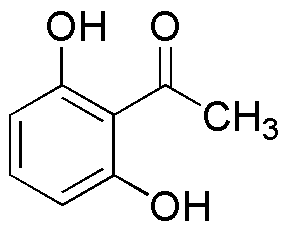2,6-Dihydroxyacetophenone is widely utilized in research focused on:
- Pharmaceutical Development: This compound serves as a key intermediate in the synthesis of various pharmaceuticals, particularly in the development of anti-inflammatory and analgesic drugs.
- Antioxidant Applications: Due to its antioxidant properties, it is used in formulations aimed at protecting skin from oxidative stress, making it valuable in cosmetic and skincare products.
- Analytical Chemistry: It acts as a reagent in analytical methods for detecting metal ions, which is essential in environmental monitoring and quality control in manufacturing.
- Polymer Industry: The compound is incorporated into polymer formulations to enhance thermal stability and improve mechanical properties, benefiting industries that require durable materials.
- Food Industry: It is used as a food additive for its flavoring properties, providing a unique taste profile in various food products while also acting as a preservative.
General Information
Properties
Safety and Regulations
Applications
2,6-Dihydroxyacetophenone is widely utilized in research focused on:
- Pharmaceutical Development: This compound serves as a key intermediate in the synthesis of various pharmaceuticals, particularly in the development of anti-inflammatory and analgesic drugs.
- Antioxidant Applications: Due to its antioxidant properties, it is used in formulations aimed at protecting skin from oxidative stress, making it valuable in cosmetic and skincare products.
- Analytical Chemistry: It acts as a reagent in analytical methods for detecting metal ions, which is essential in environmental monitoring and quality control in manufacturing.
- Polymer Industry: The compound is incorporated into polymer formulations to enhance thermal stability and improve mechanical properties, benefiting industries that require durable materials.
- Food Industry: It is used as a food additive for its flavoring properties, providing a unique taste profile in various food products while also acting as a preservative.
Documents
Safety Data Sheets (SDS)
The SDS provides comprehensive safety information on handling, storage, and disposal of the product.
Product Specification (PS)
The PS provides a comprehensive breakdown of the product’s properties, including chemical composition, physical state, purity, and storage requirements. It also details acceptable quality ranges and the product's intended applications.
Certificates of Analysis (COA)
Search for Certificates of Analysis (COA) by entering the products Lot Number. Lot and Batch Numbers can be found on a product’s label following the words ‘Lot’ or ‘Batch’.
Numéro de catalogue
Numéro de lot/série
Certificates Of Origin (COO)
This COO confirms the country where the product was manufactured, and also details the materials and components used in it and whether it is derived from natural, synthetic, or other specific sources. This certificate may be required for customs, trade, and regulatory compliance.
Numéro de catalogue
Numéro de lot/série
Safety Data Sheets (SDS)
The SDS provides comprehensive safety information on handling, storage, and disposal of the product.
DownloadProduct Specification (PS)
The PS provides a comprehensive breakdown of the product’s properties, including chemical composition, physical state, purity, and storage requirements. It also details acceptable quality ranges and the product's intended applications.
DownloadCertificates of Analysis (COA)
Search for Certificates of Analysis (COA) by entering the products Lot Number. Lot and Batch Numbers can be found on a product’s label following the words ‘Lot’ or ‘Batch’.
Numéro de catalogue
Numéro de lot/série
Certificates Of Origin (COO)
This COO confirms the country where the product was manufactured, and also details the materials and components used in it and whether it is derived from natural, synthetic, or other specific sources. This certificate may be required for customs, trade, and regulatory compliance.


